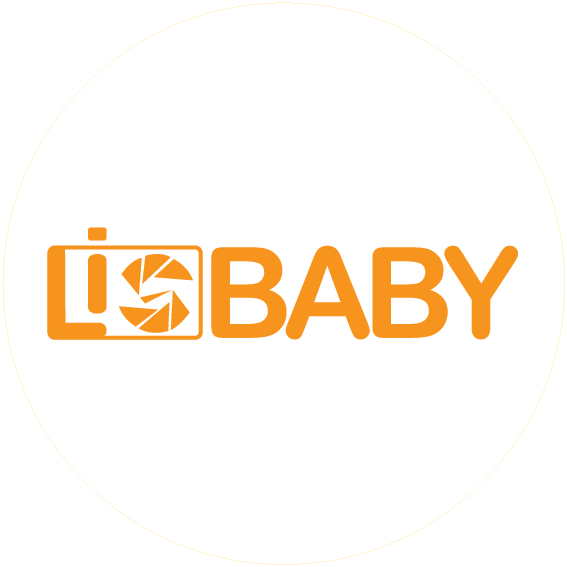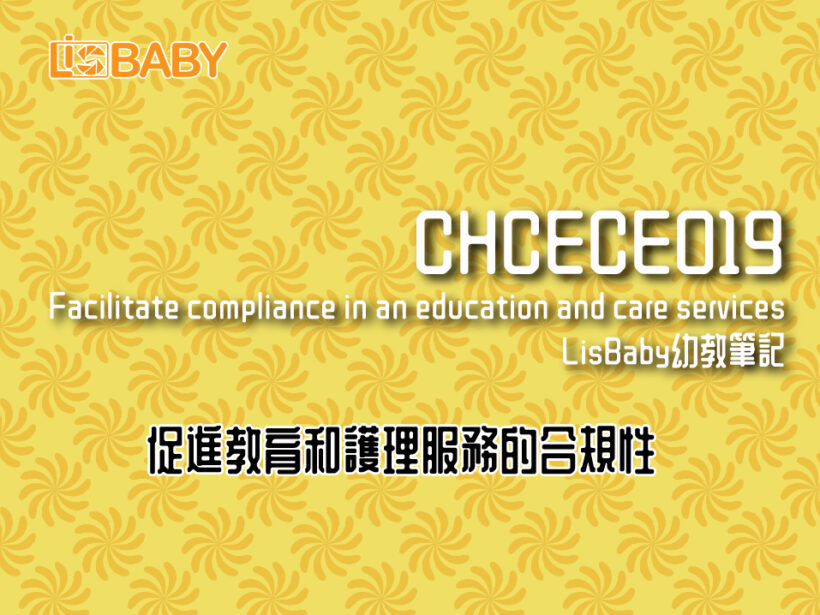今天小編跟大家分享的澳洲幼教課題是「CHCECE019 Facilitate compliance in an education and care services」 中文翻譯是:「促進教育和護理服務的合規性」。以下內容是小編個人認為的課題重點,如果你覺得有什麼需要補充,歡迎留言分享。
National Quality Framework for Early Childhood Education and Care (NQF) applies to the following services:
- Long day care.
- Family day care.
- Preschool.
- Kindergarten.
- Outside school hours care.
The NQF is comprised of three elements:
- National Quality Standard – determines the benchmark for the quality of education and care services across Australia.
- National Legislative Framework – provides a consistent approach to the regulation and assessment of education and child care services.
- National Quality Rating and Assessment process – rates education and care providers against the National Quality Standard.
The 7 areas of assessment are known as a ‘Quality Area’:
- Quality Area 1 – Educational program and practice.
- Quality Area 2 – Children’s health and safety.
- Quality Area 3 – Physical environment.
- Quality Area 4 – Staffing arrangements.
- Quality Area 5 – Relationships with children.
- Quality Area 6 – Collaborative partnerships with families and communities.
- Quality Area 7 – Governance and leadership.
The assessment criteria of the NQS are intrinsically linked to the two National learning frameworks:
- Belonging, Being and Becoming: The Early Years Learning Framework for Australia – this framework outlines the principles, practices and outcomes for successful development and learning of a child from birth to five years old and includes the transition to school. All education and child care services are expected to use this framework to develop and implement their own provision.
- My Time, Our Place: Framework for School Age Care in Australia – this framework supports the continued development of learning and development of children during school-age using best practices of learning through play and leisure-based activities that are appropriate to the individual’s needs, abilities and interests.
The National Quality Framework includes legal requirements that all services must comply with:
- The number of staff and their qualifications.
- Ensuring children’s health and safety.
- Service space and layout.
- The quality of developmental and learning experiences for children.
There are Regulatory Authorities in each state and territory. Regulatory Authorities can provide information on:
- Information about assessments and ratings.
- Certifying and approving supervisors.
- Submitting application and notification forms.
The educational program must contribute to each of the following outcomes:
- Children have a strong sense of identity.
- Children are connected with and contribute to his or her world.
- Children have a strong sense of wellbeing.
- Children are confident and involved learners.
- Children are effective communicators.
Information about the legislation can be provided to staff (and stakeholders) through:
- Training or induction guides.
- Posters.
- Workshops.
- Meetings.
- Links and information on the organisation’s website.
- Newsletters.
The understanding of NQF and other relevant legislation can be achieved in several ways. For example, through:
- Observations of staff.
- Team meetings.
- One-to-one reviews.
- Professional development opportunities.
Each provider is assessed in seven different areas and also given an overall rating. The seven areas of assessment are:
- Educational program and practice.
- Children’s health and safety.
- Physical environment.
- Staffing arrangements.
- Relationships with children.
- Collaborative partnerships with families and communities.
- Leadership and service management.
Each quality area will be rated with one of the five following levels defined by the National Quality Standard:
- Excellent rating – awarded by ACECQA.
- Exceeding National Quality Standard.
- Meeting National Quality Standard.
- Working Towards National Quality Standard.
- Significant Improvement Required.
The unstructured observation will ‘observe’ and ‘record’ a behaviour, without any form of a set guideline, for example:
- Observing the child in creative play.
- Observing the child in an improvised play.
- Observing the child interacting with their peers.
- Observing the child’s attention span and ‘boredom’ indicators.
The structured observation has a determined composition for the educator to follow, for example:
- Observing an ‘event’ that looks for ‘key behaviours’ and then completing a checklist on whether or not those behaviours occurred.
- Making notations on all that happened during an observation on a pre-determined form.
- Observing goal-oriented activities and completing a set of questions concerning that activity.
- Observing an activity and immediately documenting the interpretation of that activity, i.e. the conditions, the time of day.
The community representatives may include:
- Nurse.
- Doctor.
- Health visitor.
- Counsellor.
- Social worker.
- Safeguarding officer.
- Behavioural support worker.
- Speech therapists.
- Child psychiatrists.
- Educational psychologists.
- Play therapists and play-scheme workers.
Staff can collect, and collate, information through:
- Speaking with parents and carers.
- Carrying out and recording surveys.
- Observing each other working with children and documenting their findings – a checklist could be used for practices demonstrated.
- Performance reviews with managers.
- Writing and sending requests for information to parents, carers, members of the community, or other professionals that are involved in a child’s care.
- Gathering information known about the child, notes and assessments on development.
- Ensuring communication books and scrapbooks are up-to-date – staff may need to take additional photographs, or link the experiences documented with appropriate standards and practices.
- Ensuring each child’s file and all other documentation is complete.
The educator has to consider how the quality area is achieved within their organisation. To do this, asking colleagues several pertinent questions will assist in ensuring that this quality area is met. An example of relevant questions could be:
- How do we gain knowledge and understanding of the learning framework?
- How do we ensure higher learning outcomes for all ages?
- How are we able to learn about children – their abilities, interests and strengths?
- How do we ensure children’s experiences are focused on the child and not the adult?
- How do we help children to participate?
- How do we make decisions and who is involved?
- How do we show children that we value their thoughts and ideas?
- How do we assess the development of children through ongoing planning, documenting and evaluation?
- Do we scaffold learning?
- Do we intentionally teach?
- Do we regularly reflect on children’s development – both as a group and as individuals?
The three main components, in summary, would be:
- A statement about the organisation’s philosophy.
- An assessment of own practices and how they match up to the National Regulations and National Quality Standard.
- Areas that you think may need improvement.
List professionals the educator should collaborate with to create an effective quality improvement plan:
- Colleagues.
- Clients.
- Managers and supervisors.
- Teachers, professors, trainers and other educators.
- Care workers.
- Regulators.
- Lawyers.
List behaviours the educator must adopt when collaborating with others about the quality improvement plan:
- Adopt and maintain a proactive and positive attitude.
- Be patient and diplomatic at all times.
- Be prepared to compromise.
- Respect other peoples’ points of view.
- Mediate in disputes where necessary.
- Ask for frequent expansion on points that are not clear.
Reviewing the quality improvement plan will help to:
1. Check that practices are being implemented as planned.
2. Check the progress of each change.
3. Identify and rectify any issues with new practices.
4. Ensure everyone is informed of the changes.
5. Prevent complacency issues.
6. Update and document practices that have been successfully established.
7. Keep to the proposed schedule for changes to be implemented.
The first step is to identify the stakeholders. Stakeholders may include:
- Owners or managers.
- Users of the service, eg parents.
- Staff members.
- Education providers.
- Association officials or members.
- Union representatives.
Here is an example of how to structure a meeting for self-assessment and preparation for submitting a performance plan:
1. Decide on a meeting time and date.
2. Notify the participants of the meeting, with an official invitation.
3. Issue the topics open for discussion.
4. Have a qualified person present to be the official minutes’ taker.
Have the chair of the meeting do an introduction, including:
1. Summary of progress to date.
2. Topics for discussion.
Open the meeting with a summary of:
1. Individual responsibilities.
2. Accountabilities.
3. Feedback.
4. Update the work being done by various teams or departments.
5. Conduct questions and answers.
Make a statement that includes:
1. A summary.
2. A conclusion, which enables the chair of the meeting to answer any queries and provide a last motivational boost.
Colleagues who should be part of the shared information at the setting, include:
- Room leaders.
- Nursery nurses.
- Supervisors or managers.
- Educators.
- Administration support.
- Students.
- Cleaners.
- Volunteers.
【關於LisBaby旅食百變】
 訂閱“LisBaby旅食百變的YouTube頻道”看新片!
訂閱“LisBaby旅食百變的YouTube頻道”看新片! 追蹤“LisBaby旅食百變的Facebook專頁”了解最新動向!
追蹤“LisBaby旅食百變的Facebook專頁”了解最新動向! 更新“LisBaby旅食百變的網站”看新的文章吧!
更新“LisBaby旅食百變的網站”看新的文章吧! 歡迎商業合作請「聯絡我們」感謝!
歡迎商業合作請「聯絡我們」感謝!

